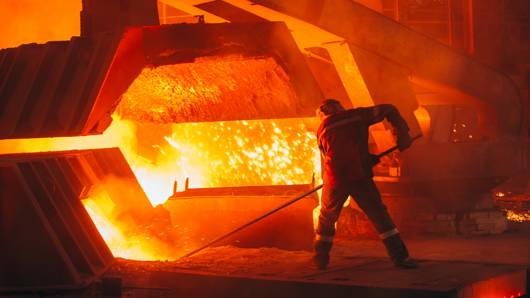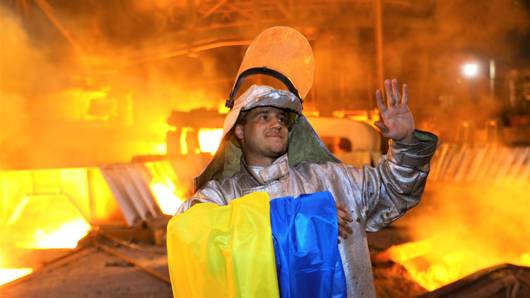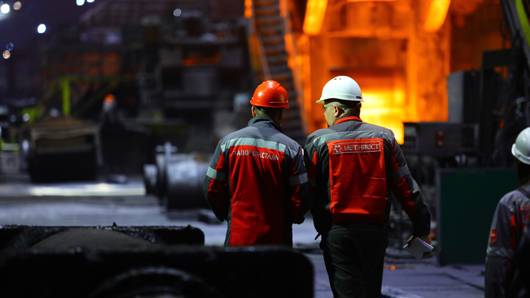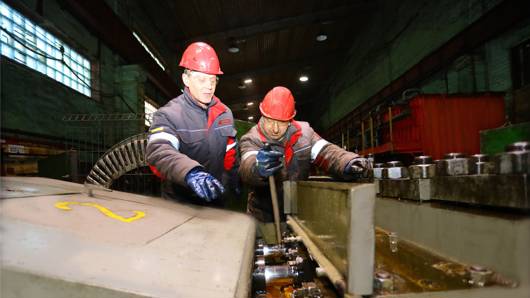The Washington Post, a prominent American newspaper, has penned an extensive article outlining the history of the Ukrainian steel industry. It details its current situation following 1.5 years of war and highlights the primary challenges the industry has encountered due to the Russian invasion. This narrative is told through the perspective of Zaporizhstal and the Metinvest Group.
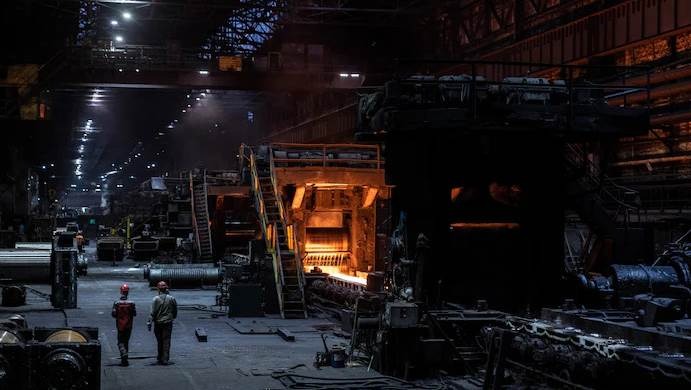
A stream of molten metal moves through the production line at the Zaporizhstal steel plant in Zaporizhzhia, Ukraine, on May 29. (Heidi Levine for The Washington Post)
The air raid alarm doesn’t care if the blast furnace is blowing. So when the siren sounds warning of a missile attack, which is often, Oleksii Klashnik doesn’t run down to one of Zaporizhstal’s 16 underground bunkers. Instead, he and a few key workers don protective vests along with their heatproof outfits. Then they continue working with the molten metal at temperatures up to 1,100 degrees Celsius.
Zaporizhzhia city is less than 30 miles from the front line in Ukraine’s high-stakes counteroffensive and has been frequently targeted by Russian forces. The air alarm signals real danger. But stopping a blast furnace in the middle of smelting molten iron used to create steel could be even riskier.
“People just adapted to it,” Klashnik, 29, said with a shrug. Despite the war, lives and livelihoods must go on — and Zaporizhstal, one of the largest steel mills in Ukraine, is a symbol of resilience in one of the core sectors of the country’s battered economy. The plant has never been hit, Klashnik added, but “you can definitely hear the explosions in the city.”
Founded in 1933, Zaporizhstal is one of few mills that produces cold-rolled sheets of steel, vital for car manufacturers. It is a regional giant and workers describe its mammoth scale in abstract terms — you can fit two-and-a-half Monacos in here, they say, or 777 soccer pitches.
More than that, however, they describe it as evidence of Ukraine’s refusal to surrender to Russian aggression. The plant closed for 33 days at the start of the war but has operated ever since, retooling to help Ukraine’s national war effort despite the risk.
Because of the war, the giant Zaporizhstal has effectively shrunk. Roughly 10,000 people worked at the plant before the invasion. Last year, a thousand left to become soldiers. Another thousand, mostly women or men with families, moved away. Zaporizhstal has not operated at more than 70 percent capacity since the war began. Currently, just two of four furnaces are working (one is undergoing minor repairs), so production is even lower.
“We lost a lot of our clients," Roman Slobodianiuk, general director, said in an interview.
The struggles in the steel industry in many ways mirror the broader hardship wrought on Ukrainian industry since the invasion.
Ukraine’s economy shrank by 30 percent in 2022. Though the decline has stabilized this year, it is not clear when growth will return. Many in Ukraine’s steel industry worry they are falling behind as global production transitions to “green” steel, which uses hydrogen rather than fossil fuels and requires a different type of iron ore.
For many, it’s a personal struggle, too. Steel mills typically dominate their home cities, connecting families and serving as mainstays of the tax base. Several generations of a family might work together in hot, potentially dangerous conditions.
“Ukraine has a steel production culture,” said Stanislav Zinchenko, chief executive of GMK, a Kyiv-based economic think tank.
A steel production culture
That culture took hundreds of years to build up. In the 19th century, British investors began working with the Russian empire to tap the country’s enormous reserves of iron ore. Later, during the Soviet Union, much of this iron ore was used in steel designed for manufacturing in the domestic market.
When the Soviet Union collapsed, the industry pivoted, making use of the wide Dnieper River and the nearby Black Sea to export products as far away as North America and Asia. It became one of Ukraine’s largest industries, second only to the vast fields of agriculture like those that are just outside the city in the Zaporizhzhia region.
Before the Russian invasion, Ukraine was one of the world’s largest suppliers of iron and steel, with metals making up roughly a third of Ukraine’s exports. It contributed one dollar out of every 10 to Ukraine’s prewar economy and more than 560,000 people were directly or indirectly employed by the industry.
It can be tough work. New employees on the production line at Zaporizhstal were warned that they would sweat out 10 kilograms, or 22 pounds, in their first month on the job.
The impact of the war on the steel industry was highlighted by the scenes at Azovstal Steel Plant in occupied Mariupol last year. That plant, as Zaporizhstal, is part of Metinvest, the metals giant owned by Rinat Akhmetov, Ukraine’s richest man.
Metinvest, Ukraine’s largest employer before the war, had about 35,000 workers in Mariupol alone. The Azovstal mill and its web of underground bunkers became an iconic holdout of Ukrainian military resistance before Russia took over the city more than a year ago.
For the steel mills still operating in Ukrainian-held territory, there were other problems. They were cut off from the iron ore mines that once supplied them and they suffered rolling blackouts as Russian airstrikes targeted the electrical grid.
The recent collapse of the Kakhovka dam farther down the Dnieper River added a new problem: water. On Tuesday, a giant steel plant in Kryvyi Rih owned by metals giant ArcelorMittal announced that it would halt production indefinitely because of water supply issues.
Even when steel could be produced, the Russian blockade of Ukrainian ports meant lost access to international shipping that helped Ukraine thrive. Exports now travel via rail to Eastern Europe at a significant cost, limiting sales.
“What the Russians are doing now, it’s called by a very simple word: piracy,” Yuriy Ryzhenkov, chief executive of Metinvest, said.
To give in or to break down
For workers such as Klashnik, the biggest change isn’t the sirens: It’s the hours. The shifts were lengthened from eight hours to 12 last year. The aim was to fit around the city’s nightly curfew, which keeps Zaporizhzhia residents indoors at night. It meant four more hours a day of hot, sweaty work at the furnace.
In the long run, staffing will probably be a major concern at Zaporizhstal, pointing to bigger issues surrounding the future of Ukraine’s heavy industry. Plant officials say that they are struggling to fill some specialist vacancies as that kind of skilled worker no longer lives in the area.
Metinvest originally hoped to find jobs across the company for 6,000 workers displaced from its facilities in Mariupol, but only half that number applied. Many opted to remain in Russian-held territory for personal reasons.
“It was a bit surprising for us,” said Ryzhenkov, adding that the limited number of jobs in Ukraine and language barriers in Europe were a factor. “So they chose to stay in Mariupol."
Slobodianiuk, who is 34 himself, admits it is hard to convince young people that they should go for a job in a steel mill rather than, say, information technology, even though steel jobs pay well. “It’s hard physical labor,” said Slobodianiuk. “Not a lot of people are ready to commit to it.”
Roughly 7 million people have left Ukraine since the war began, compounding a long-standing demographic problem. Millions more have moved to Ukraine’s west, away from traditional industrial hubs such as Zaporizhzhia. And with military spending expected to remain high for years, hundreds of thousands of soldiers will be taken out of the job market.
The war has also meant that Metinvest and other steel producers in Ukraine have fallen behind in the industry-wide race to move away from traditional steel, fed by coal and a major source of carbon emissions, to green steel. Countries such as China, India and South Africa have taken Ukraine’s place in international steel markets. Though Russian steel is sanctioned, its iron ore is not.
“Today the main supplier for Europe’s steel industry is Russia,” said Zinchenko, referring to the sponge iron and other special ore produced by Metalloinvest, a Russian producer whose largest shareholder is the sanctioned oligarch Alisher Usmanov. “Amazing, right? It should be Ukraine.”
The fame of Azovstal made Ukraine’s steel industry a source of national pride. But keeping the industry alive will require grappling with what sort of country Ukraine wants to be after the war.
“I was proud to work here before the war," said Klashnik as he stood back from the furnace. "And now, it’s the same.”






